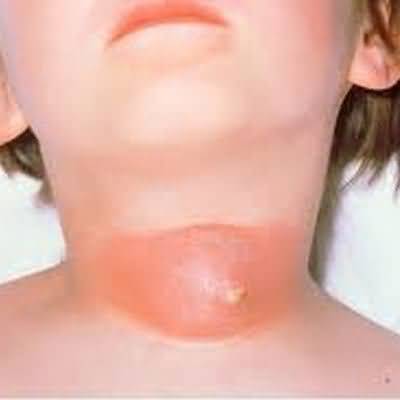deep neck infections
deep neck infections
ESSENTIALS OF DIAGNOSIS
General Considerations
Ludwig angina is the most commonly encountered neck space infectionIt is a cellulitis of the sublingual and submaxillary spaces, often arising from infection of the mandibular dentition
Deep neck abscesses most commonly originate from odontogenic infections
Other causes include suppurative lymphadenitis, direct spread of pharyngeal infection, penetrating trauma, pharyngoesophageal foreign bodies, cervical osteomyelitis, and intravenous injection of the internal jugular vein, especially in drug abusers
Recurrent deep neck infection may suggest an underlying congenital lesion, such as a branchial cleft cyst
Suppurative lymphadenopathy in middle-aged persons who smoke and drink alcohol regularly should be considered a manifestation of malignancy (typically metastatic squamous cell carcinoma) until proven otherwise
Clinical Findings
Patients with Ludwig angina have edema and erythema of the upper neck under the chin and often of the floor of the mouthThe tongue may be displaced upward and backward by the posterior spread of cellulitis, and coalescence of pus is often present in the floor of mouth
This may lead to occlusion of the airway
Microbiologic isolates include streptococci, staphylococci, Bacteroides, and Fusobacterium
Patients with diabetes may have different flora, including Klebsiella, and a more aggressive clinical course
Patients with deep neck abscesses usually present with marked neck pain and swelling
Fever is common but not always present
Deep neck abscesses are emergencies because they may rapidly compromise the airway
Untreated or inad- equately treated, they may spread to the mediastinum or cause sepsis
Contrast-enhanced CT usually augments the clinical examination in defining the extent of the infection
It often will distinguish inflammation and phlegmon (requiring antibiotics) from abscess (requiring drainage) and define for the surgeon the extent of an abscess
CT with MRI may also identify thrombophlebitis of the internal jugular vein secondary to oropharyngeal inflammation
This condition, known as Lemierre syndrome, is rare and usually associated with severe headache
The presence of pulmonary infiltrates consistent with septic emboli in the setting of a neck abscess should lead one to suspect Lemierre syndrome or injection drug use, or both
Treatment
Usual doses of penicillin plus metronidazole, ampicillinsulbactam, clindamycin, or selective cephalosporins are good initial choices for treatment of Ludwig anginaCulture and sensitivity data are then used to refine the choice
Dental consultation is advisable to address the offending tooth or teeth
External drainage via bilateral submental incisions is required if the airway is threatened or when medical therapy has not reversed the process
Treatment of deep neck abscesses includes securing the airway, intravenous antibiotics, and incision and drainage
When the infection involves the floor of the mouth, base of the tongue, or the supraglottic or paraglottic space, the airway may be secured either by intubation or tracheotomy
Tracheotomy is preferable in the patients with sub- stantial pharyngeal edema, since attempts at intubation may precipitate acute airway obstruction
Bleeding in association with a deep neck abscess is very rare but suggests carotid artery or internal jugular vein involvement and requires prompt neck exploration both for drainage of pus and for vascular control
Patients with Lemierre syndrome require prompt institution of antibiotics appropriate for Fusobacterium nec- rophorum as well as the more usual upper airway pathogens
The use of anticoagulation in treatment is of no proven benefit


















